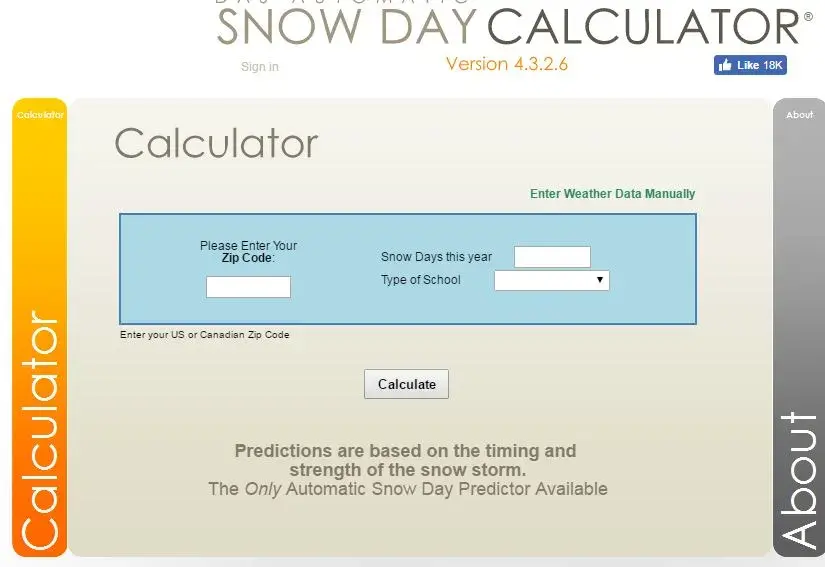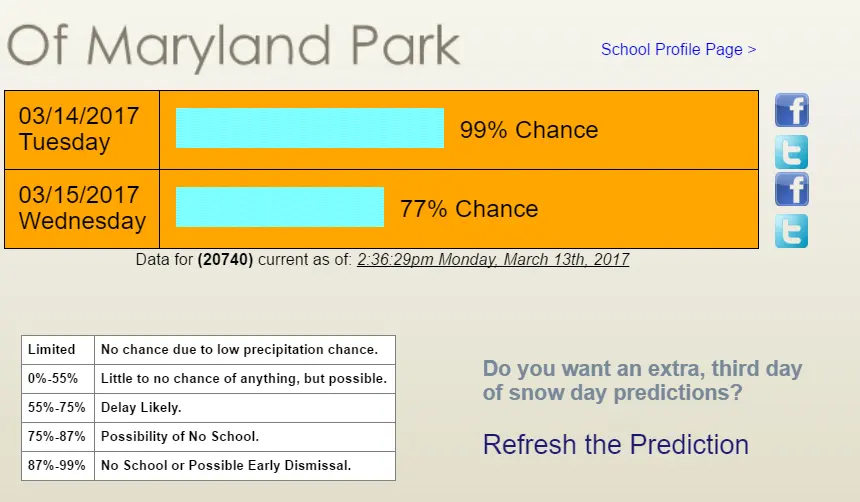When winter arrives, many students and parents eagerly await the possibility of a snow day. The thought of a day off from school, filled with hot chocolate, cozy blankets, and maybe even a bit of fun in the snow, can be very exciting. But how do schools decide when to cancel classes due to snow? Enter the “snow day calculator,” a tool designed to help predict when your school may close because of heavy snow. In this article, we’ll explore what a snow day calculator is, how it works, and how it can help you stay prepared for snowy days.
What is a Snow Day Calculator?
A snow day calculator is an online tool or app that helps predict whether schools will be closed due to snow or bad weather. It takes into account various factors like snow accumulation, temperature, road conditions, and even school policies to make an educated guess about school closures. It’s not always 100% accurate, but it offers a helpful way to anticipate whether a snow day is on the horizon.
Why Do Schools Close for Snow?
Before we dive deeper into how a snow day calculator works, let’s first understand why schools close due to snow in the first place.
- Safety Concerns: The primary reason schools close for snow is the safety of students and staff. When snow accumulates, roads become slippery, which can lead to dangerous driving conditions. If buses can’t safely transport students or if it’s unsafe for students to walk to school, school administrators may decide to close.
- Temperature and Weather Conditions: Extremely cold temperatures, combined with snow or ice, can cause serious health risks. For instance, frostbite or hypothermia can occur in very cold conditions, especially when children are waiting for buses or walking to school. Snow day calculators often factor in the wind chill and forecasted temperatures to predict whether conditions will be dangerous.
- School Infrastructure: Sometimes, schools close because they cannot maintain the building or ensure safe conditions inside. For example, heavy snow or ice could cause a power outage, making it impossible for schools to remain open. In such cases, closures are necessary to protect both students and staff.
- Government or District Policy: Many schools have specific policies for snow days that are based on local climate, the severity of the snowstorm, and transportation options. Some districts automatically cancel school when a certain amount of snow is predicted, while others may wait until the weather conditions worsen before making a decision.
How Does a Snow Day Calculator Work?

A snow day calculator uses data from weather forecasts, local conditions, and sometimes even historical data to predict the likelihood of a snow day. Let’s take a look at the various elements that go into making this prediction:
- Weather Forecast: The snow day calculator will rely on weather forecasts that predict snow accumulation, temperature, and other weather conditions such as wind speed and direction. Weather services like the National Weather Service or local meteorological agencies provide the data that informs these calculations.
- Snow Accumulation: One of the most important factors is how much snow is expected to fall. A few inches of snow may not be enough to cancel school, but heavier snow accumulation can make roads impassable and make it difficult to open the school safely. The calculator often compares the forecasted snow depth to historical snow data in the area.
- Wind Chill: Wind chill is the factor that makes cold temperatures feel even colder. Snow day calculators will often consider the wind chill index, which indicates how cold it feels outside when wind is factored in. Very cold wind chills can be dangerous for children walking to school, which may increase the likelihood of a snow day.
- Road Conditions: Road conditions are a major concern during snowstorms. If the roads are icy or snow-covered, it can be dangerous for school buses to drive, even if the snow isn’t too heavy. Snow day calculators often include traffic reports and the expected impact on local roads to gauge how easily students and staff can reach the school.
- Local Government Reports: Local government agencies may issue warnings or advisories during winter storms that can impact schools. These warnings help school administrators make decisions about closures. A snow day calculator may integrate these reports to provide more accurate predictions.
- School District Policy: Finally, many school districts have guidelines about what amount of snow or what types of weather events warrant a school closure. Some districts might close schools automatically when a certain level of snow is forecasted, while others may take a more cautious approach and wait until the last minute to make a decision.
Can You Rely on a Snow Day Calculator?
While a snow day calculator can provide a helpful prediction, it’s important to understand that it is not always 100% accurate. Weather conditions can change rapidly, and decisions about school closures are often made based on a combination of weather reports and local conditions.
However, these calculators are a great starting point to give you an idea of what to expect. They use a wide range of data sources to make predictions, so they are generally reliable, especially when forecasting snow events that have a high chance of affecting travel conditions.
Tips for Using a Snow Day Calculator Effectively
- Check Multiple Sources: Use the snow day calculator alongside other weather prediction tools. Look at local news stations or trusted weather apps to get a complete picture of the storm and its potential impact on your area.
- Understand the Variables: Know what factors influence school closures in your area. For example, does your school district tend to close schools for just a few inches of snow, or do they wait until the snow accumulation is much heavier? This information can help you understand the snow day calculator’s predictions better.
- Consider the Timing: Weather conditions can change quickly, so even if the snow day calculator predicts a closure, it’s a good idea to stay updated throughout the day. If the storm worsens or if new weather information becomes available, the closure status may change.
- Be Prepared Early: Even if you’re not sure about whether school will be canceled, it’s a good idea to prepare for the possibility of a snow day. Have your winter gear ready, keep some extra snacks in the pantry, and make sure you have a backup plan in case you need to stay home from school unexpectedly.
- Use Alerts and Notifications: Many snow day calculators and weather apps allow you to set up notifications so that you can get alerts as soon as there’s an update about school closures. This can help you stay on top of any changes without having to constantly check the weather.
Benefits of Using a Snow Day Calculator
- Time-Saving: A snow day calculator saves you the time and effort of constantly checking weather forecasts. It provides a prediction all in one place, so you can quickly get an idea of whether school will be canceled.
- Reduces Stress: Instead of waiting in uncertainty for the decision to be made, a snow day calculator can help you plan ahead. If a snow day is likely, you can prepare for the day off and enjoy it.
- Increases Accuracy: While it’s not perfect, a snow day calculator combines data from multiple sources to give you a more accurate prediction than relying on a single weather report or guesswork. This can help you make decisions about whether to plan for a snow day or not.
- Convenient: Many snow day calculators are available as apps or websites, so you can easily access them from your phone or computer. This makes it easy to stay updated wherever you are, whether you’re at home or on the go.
How Accurate Are Snow Day Predictions from Calculators?
While snow day calculators offer valuable predictions, they are not foolproof. These calculators rely on weather forecasts, historical data, and local reports, but weather conditions can change rapidly. Snowfall predictions, road conditions, and temperature fluctuations are subject to change, and sometimes these calculators may not predict last-minute closures. However, they provide a solid starting point for anticipating whether school will be closed, especially if the forecast predicts significant snow accumulation and hazardous conditions.
Can Snow Day Calculators Be Used in Any Region?
Snow day calculators can generally be used anywhere that experiences snowfall, but their effectiveness may vary depending on the region. Some areas have very specific weather patterns, so calculators tailored to your region will yield more accurate predictions. For example, regions with heavy snowfall year after year, like the Northeast or Midwest in the United States, may have better local calculators that take into account specific school district policies and weather behaviors in those areas. It’s best to use a calculator that takes local climate and infrastructure into account.
Are Snow Day Calculators Useful for Parents and Teachers?

Yes! Both parents and teachers can benefit from using snow day calculators. Parents can use the tool to stay ahead of the curve when it comes to planning snow day activities, while teachers can plan their schedules accordingly. A snow day prediction tool helps ensure that everyone is prepared, avoiding surprises and reducing stress on snow days. Parents can also use the calculator to prepare in advance for childcare needs or ensure that students are safe and warm during extreme weather conditions.
How Do Schools Factor in Transportation When Deciding to Close?
Transportation is one of the most critical factors when deciding whether to close schools due to snow. School districts consider whether buses can safely navigate snow-covered or icy roads, and whether students can walk to school safely. The snow day calculator may take into account real-time traffic reports and road conditions to assess how easily students and staff can travel. If road conditions are deemed unsafe, many schools will close to ensure the safety of everyone involved. It’s a major reason why the calculator takes into consideration road conditions and not just snow accumulation.
What Are the Best Snow Day Calculator Apps Available?
There are a variety of snow day calculator apps available, each with its own features and reliability. Some popular apps include Snow Day Predictor, Weather.com, and AccuWeather, which offer snow day predictions based on localized weather forecasts and real-time reports. For those specifically looking for a snow day calculator, SnowDayForecast.com offers predictions based on snow depth, temperature, and local school policies. Exploring different apps will help you find the one that best meets your needs for accurate, timely predictions.
FAQS
What is a Snow Day Calculator?
A snow day calculator predicts if your school will be closed due to snow or bad weather using weather data and road conditions.
How Accurate is a Snow Day Calculator?
It’s usually accurate but not always. Weather changes quickly, so predictions might not always match the actual closure.
Can a Snow Day Calculator Be Used Anywhere?
Yes, but it’s most accurate in areas with regular snow. It may be less reliable in regions with rare snowfalls.
Do All Schools Use Snow Day Calculators?
Not all schools use them, but many rely on weather reports and local conditions to decide on closures.
Can Snow Day Calculators Predict Other Weather Closures?
Some calculators also consider other weather issues like ice or freezing rain, but it depends on the tool you use.
Conclusion
A snow day calculator is a fun and useful tool that can help you predict whether school will be canceled due to snow and other weather conditions. While no prediction can be guaranteed, these calculators take into account important factors like snow accumulation, temperature, wind chill, and road conditions to give you a reliable estimate of what to expect.
By using a snow day calculator in combination with other weather sources, you can stay informed and prepared for winter storms. Keep in mind that these tools offer predictions, not guarantees, so it’s always a good idea to check for the latest updates and prepare for any scenario.
So, the next time you wake up and see snow falling outside your window, you’ll know exactly where to check to find out if it’s a snow day—or just another chilly morning!

Leave a Reply